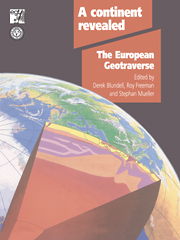3 - EUROPE'S LITHOSPHERE – SEISMIC STRUCTURE
Published online by Cambridge University Press: 05 November 2009
Summary
SEISMIC METHODS FOR EXPLORING THE CRUST AND UPPER MANTLE OF EUROPE
Methods for exploring the Earth's interior which follow the passage of seismic waves through the ground are adapted according to the scale on which the Earth is viewed. The resolution of the seismic method utilised governs the clarity of the image of the Earth's structure and the extent of information on physical properties. In general, the deeper the investigation, the lower the resolution and the more blurred is the image. Normal incidence seismic reflection techniques provide the best resolution, particularly in a vertical sense, and deep seismic reflection profiles have yielded spectacular views of the detailed structure of the crust and upper mantle to depths of 60 km in recent years. EGT has been able to take advantage of the work of a number of deep seismic reflection profiling programmes, particularly BIRPS (UK), CROP (Italy), DEKORP (Germany), ECORS (France) and NFP 20 (Switzerland). However, this method gives poor information on seismic velocities, for which wide-angle reflection and refraction experiments are much better suited (Giese et al. 1976). These too, provide good resolution and strong control on the properties of the crust and upper mantle but to reach depths of 200 km needed to explore the full thickness of the lithosphere, quite elaborate and large-scale experiments have to be conducted along profiles at least 1500 km in length, firing several tens of explosions with dynamite charges measured in tons into large arrays of seismometers spaced 2–3 km apart along the entire length of the profile.
- Type
- Chapter
- Information
- A Continent RevealedThe European Geotraverse, Structure and Dynamic Evolution, pp. 33 - 70Publisher: Cambridge University PressPrint publication year: 1992
- 49
- Cited by



